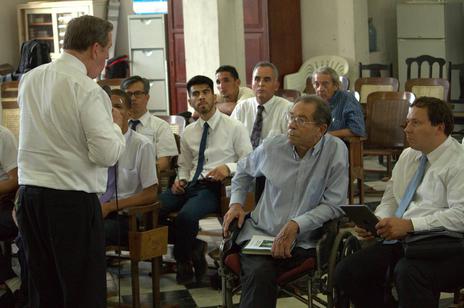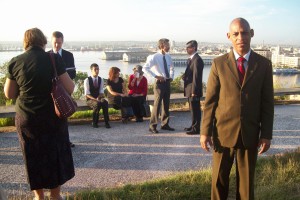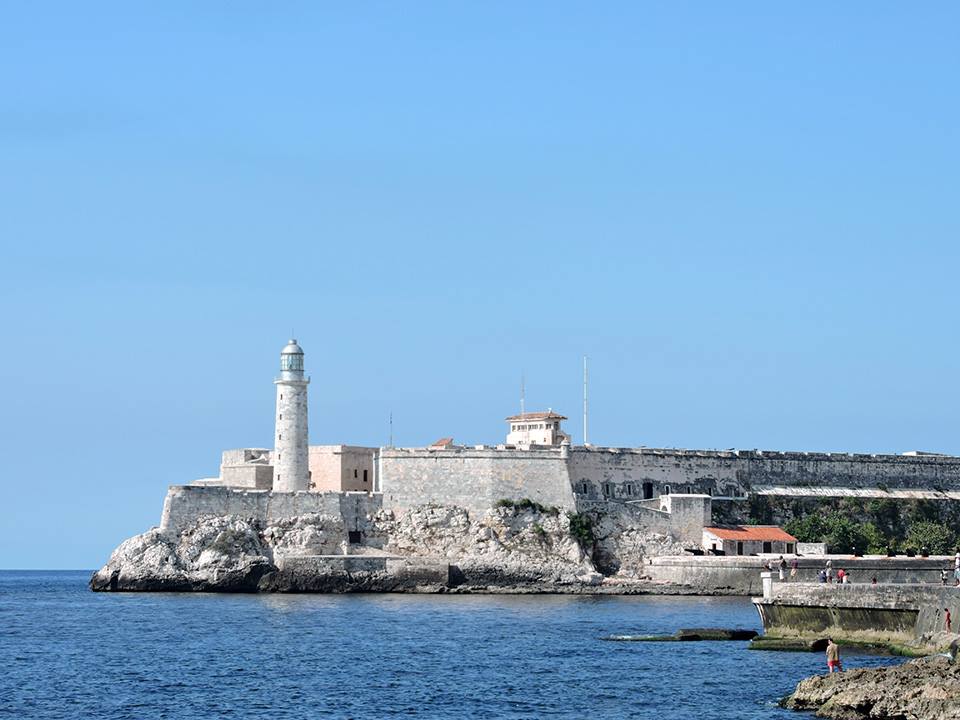THE MORMONS IN CUBA.
The Church of Jesus Christ of Latter-day Saints.
La Iglesia de Jesucristo de los Santos de los Últimos Días.

Elder Jeffrey R. Holland of the Quorum of the Twelve Apostles holds priesthood training in Havana, Cuba.
Mormons don’t need much imagination to think about what normalized U.S.-Cuba relations could mean for the LDS Church in the Pearl of the Antilles.
The thoughts of a mission-minded faith turned directly to missionary work in a communist nation with two small but growing congregations of The Church of Jesus Christ of Latter-day Saints.
One church member predicted on Twitter Wednesday the church would have missionaries in Cuba by the end of 2015. Experts say that’s too optimistic. An LDS spokeswoman said it’s too early to say how events will unfold.
“We currently have a few congregations in Cuba. It’s unclear what today’s announcements may mean for the future growth of the church in Cuba or how it will relate to missionary work in that nation.”
Information about the church in Cuba has been considered sensitive until recently, said Matt Martinich, who studies LDS Church growth.
Elder David A. Bednar of the church’s Quorum of the Twelve Apostles visited Cuba and dedicated it for the preaching of the gospel in February 2012, but that action wasn’t reported until a single sentence appeared in the Church Almanac at the end of that year.
Five months ago, the Church News expanded on that information, reporting that Elder Bednar “blessed the country and its people and promised that the church would take root in the fertile Cuban soil.”
That report was part of a story about Elder Jeffrey R. Holland’s visit to Cuba this summer. On June 15, Elder Holland divided the Havana Cuba Branch, creating the second congregation in the nation, called the El Cotorro Cuba Branch.
A branch is a small LDS congregation.
“Although we are small in number, each member is precious to us, and Cuba is precious to us,” Elder Holland said.
Obama and Castro meeting, they have said, “..this might be the tipping point for the church to make the effort to send missionaries to Cuba and establish an official church presence there.”
According to independent journalist E. Hechavarria: They censored the music should not be heard, confiscate the literature that should not be read, suspended films, direct fashion, oversee everything related to religion. The D3 uses the media to send messages of hatred against the empire (USA) and its allies in the West, examples: Round and The National Television News, Radio Rebelde Mesa, etc.
The leaders of the churches recognized by the government, must necessarily visit the Religious Affairs Bureau. They receive orientation and asked “collaboration” in exchange for: travel permits, restore a church, do some procession, organizing a festival of Christian music, etc. Even in the churches, one feels a sense of being controlled.
The religious minister who is a foreigner and does not meet the established, is suspended the permit of stay.
The dozens of unrecognized churches are held by Faith and solidarity of its members. Examples: Assemblies of God, Jehovah’s Witnesses, Mormons, the Unification Church, Seventh Day Adventists and others.
Pastors of the World Council of Churches and Catholic Bishops, do not accept the new religious movements, because they are considered “foreignizers” and harmful to the Faith.
Agencies/Deseret News/Tad Walch/InternetPhotos.TheCubanHistory.com
The Cuban History, Holywood.
Arnoldo Varona, Editor.
LOS MORMONES EN CUBA.
La Iglesia de Jesucristo de los Santos de los Últimos Días.
Los mormones no necesita mucha imaginación para pensar en lo que normalizó las relaciones entre Estados Unidos y Cuba podría significar para la iglesia mormona en la Perla de las Antillas.
Los pensamientos de una fe-misión de mente volvieron directamente a la obra misionera en una nación comunista con dos pequeñas pero crecientes congregaciones de La Iglesia de Jesucristo de los Santos de los Últimos Días.

Elder Jeffrey R. Holland of the Quorum of the Twelve Apostles holds priesthood training in Havana, Cuba.
Un miembro de la iglesia predicho en Twitter Miércoles la iglesia tendría misioneros en Cuba a finales de 2015. Los expertos dicen que es demasiado optimista. Una portavoz de LDS dijo que es demasiado pronto para decir cómo se desarrollarán los acontecimientos.
“Actualmente tenemos un par de congregaciones en Cuba. No está claro lo que los anuncios de hoy pueden significar para el futuro crecimiento de la iglesia en Cuba o cómo se relacionará con el trabajo misionero en esa nación.”
Información sobre la Iglesia en Cuba ha sido considerado sensible hasta hace poco, dijo Matt Martinich, que estudia el crecimiento de la Iglesia SUD.
Élder David A. Bednar, del Quórum de la iglesia de los Doce Apóstoles, visitó Cuba y lo dedicó a la predicación del evangelio en febrero de 2012, pero que la acción no se informó hasta que una sola frase apareció en la Iglesia Almanaque al final de ese año .
Hace cinco meses, la Iglesia Noticias expandió en esa información, la presentación de informes que el élder Bednar “bendijo el país y su gente y prometió que la Iglesia sería echar raíces en la tierra cubana fértil.”
Ese informe fue parte de una historia sobre la visita del élder Jeffrey R. Holland a Cuba este verano. El 15 de junio, el élder Holland dividió la Sucursal Habana Cuba, creando la segunda congregación en la nación, llamada Cuba Branch El Cotorro.
Una rama es una pequeña congregación mormona.
“Aunque somos pequeños en número, cada miembro es preciosa para nosotros, y Cuba es preciosa para nosotros”, dijo el élder Holland.
Obama y reunión Castro, que han dicho, “..la podrían ser el punto de inflexión para la iglesia para hacer el esfuerzo de enviar misioneros a Cuba y establecer una presencia oficial de la iglesia allí.”
De acuerdo con el periodista independiente E. Hechavarría: Ellos censuran la música que no debe ser oído, confiscan la literatura que no se debe leer, películas en suspensión, de manera directa, supervisar todo lo relacionado con la religión. El D3 utiliza los medios de comunicación para enviar mensajes de odio contra el imperio (EE.UU.) y sus aliados en Occidente.
Los líderes de las iglesias reconocidas por el gobierno, deben visitar necesariamente la Oficina de Asuntos Religiosos. Ellos reciben orientación y pidió “colaboración” a cambio de: permisos de viaje, restaurar una iglesia, hacer algo de procesión, la organización de un festival de música cristiana, etc. Incluso en las iglesias, uno siente una sensación de ser controlado.
El ministro religioso que es extranjero y no cumple con lo establecido, se suspende el permiso de residencia.
Las docenas de iglesias no reconocidas están en poder de la fe y la solidaridad de sus miembros. Ejemplos: Asambleas de Dios, testigos de Jehová, los mormones, la Iglesia de la Unificación, los Adventistas del Séptimo Día y otros.
Pastores del Consejo Mundial de Iglesias y obispos católicos, no aceptan los nuevos movimientos religiosos, porque se consideran “extranjerizantes” y perjudicial para la Fe.
Agencias / Deseret News / Tad Walch / InternetPhotos.TheCubanHistory.com
La Historia de Cuba, Holywood.
Arnoldo Varona, Editor.



 THE CHURCH OF JESUS CHRIST of Latter-day Saints (The Mormons) in Cuba. + LA IGLESIA DE JESUCRISTO de los Santos de los Últimos Días (Los Mormones) en Cuba.
THE CHURCH OF JESUS CHRIST of Latter-day Saints (The Mormons) in Cuba. + LA IGLESIA DE JESUCRISTO de los Santos de los Últimos Días (Los Mormones) en Cuba.

